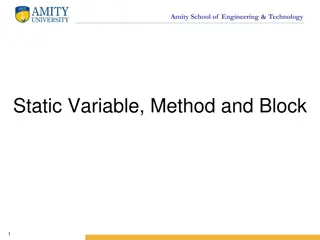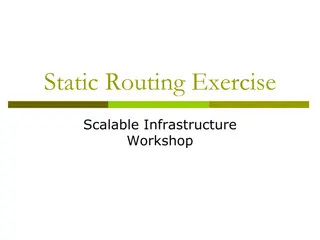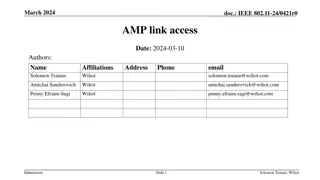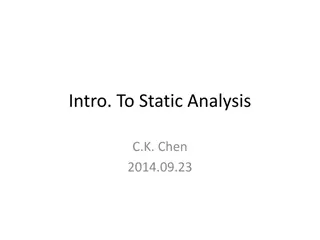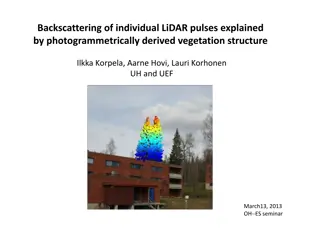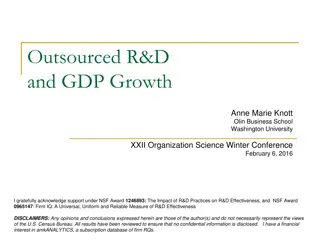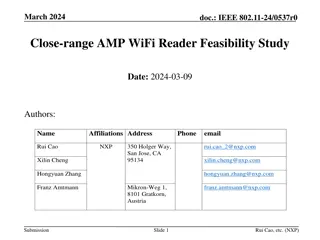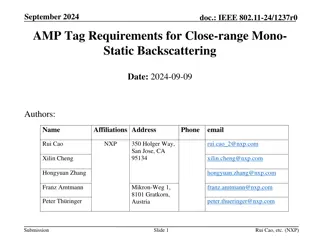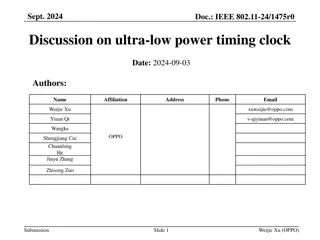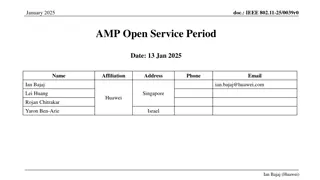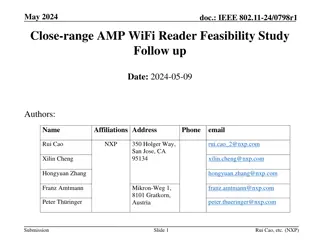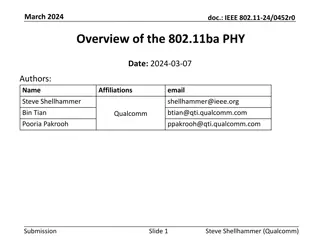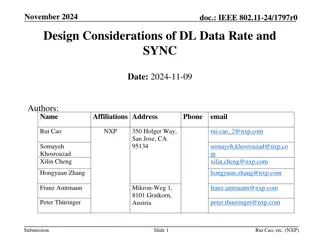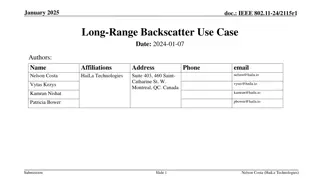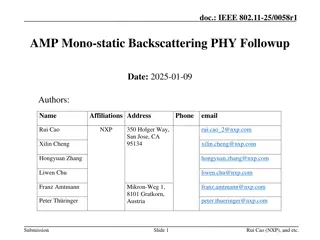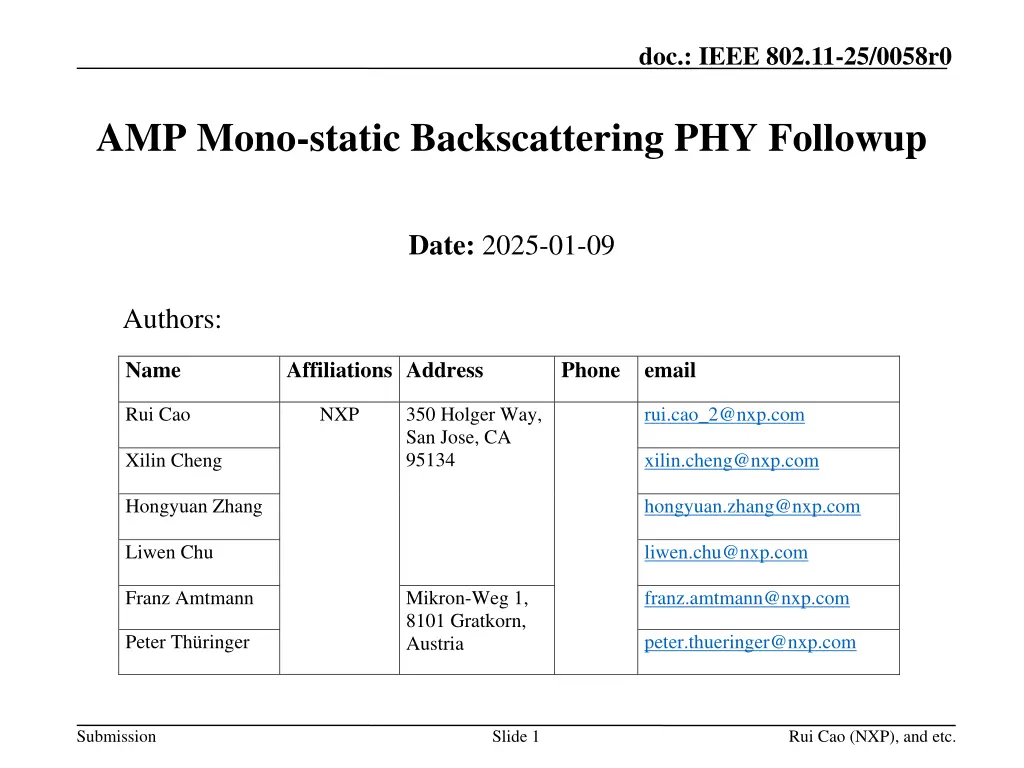
IEEE 802.11-25/0058r0 Backscattering Data Rates and Performance Analysis
Explore the latest research findings on backscattering data rates in IEEE 802.11-25/0058r0, including frequency shift designs, signal leakage issues, and proposed data rates of 1mbps and 250kbps. Discover insights on the feasibility, performance, and potential challenges of mono-static backscattering technology.
Download Presentation

Please find below an Image/Link to download the presentation.
The content on the website is provided AS IS for your information and personal use only. It may not be sold, licensed, or shared on other websites without obtaining consent from the author. If you encounter any issues during the download, it is possible that the publisher has removed the file from their server.
You are allowed to download the files provided on this website for personal or commercial use, subject to the condition that they are used lawfully. All files are the property of their respective owners.
The content on the website is provided AS IS for your information and personal use only. It may not be sold, licensed, or shared on other websites without obtaining consent from the author.
E N D
Presentation Transcript
doc.: IEEE 802.11-25/0058r0 AMP Mono-static Backscattering PHY Followup Date: 2025-01-09 Authors: Name Affiliations Address Phone email NXP Rui Cao 350 Holger Way, San Jose, CA 95134 rui.cao_2@nxp.com Xilin Cheng xilin.cheng@nxp.com Hongyuan Zhang hongyuan.zhang@nxp.com Liwen Chu liwen.chu@nxp.com Franz Amtmann Mikron-Weg 1, 8101 Gratkorn, Austria franz.amtmann@nxp.com Peter Th ringer peter.thueringer@nxp.com Submission Slide 1 Rui Cao (NXP), and etc.
doc.: IEEE 802.11-25/0058r0 Introduction [1~2], we have evaluated the feasibility and performance of 11bp mono-static backscattering. [3~5] proposed several frequency shifted backscattering designs In this contribution, several aspects of mono-static backscattering are discussed Backscattering mode: frequency shift? UL BS data rate UL BS PPDU definition Submission Slide 2 Rui Cao (NXP), and etc.
doc.: IEEE 802.11-25/0058r0 Mono-static Backscattering Direct backscattering vs frequency shift UHF RFID defines Miller Code for digital frequency shift Tag with limited digital clock rate, ~2MHz frequency shift Reader sends CW tone with narrow spectrum Rx: RF domain DC notching can remove leakage Submission Slide 3 Rui Cao (NXP), and etc.
doc.: IEEE 802.11-25/0058r0 AMP Backscattering Carrier waveform is narrow BW (e.g. >=2MHz) in 2.4GHz With tag frequency shift capability (e.g. 2MHz) Can not fully separate the signal from leakage Larger shift (say >10MHz) will cause CCA issue RF domain notching (e.g. circulators) is not available Baseband notching (analogue or digital) does not improve Rx noise floor Digital leakage removal is needed 2MHz 20dB 2MHz 2MHz Submission Slide 4 Rui Cao (NXP), and etc.
doc.: IEEE 802.11-25/0058r0 AMP Backscattering Reader Example: Digital leakage removal 2x2 WiFi: 1Tx 1Rx Achieve -35~-40dBc noise floor AMP Reader TX PA RX LNA Monostatic backscattering: Direct backscattering without frequency shift is the default operation AMP reader to perform time-domain leakage signal cancellation Frequency-shifted backscattering needs further discussions Submission Slide 5 Rui Cao (NXP), and etc.
doc.: IEEE 802.11-25/0058r0 Backscattering Data Rate [1] proposes two data rates: 1mbps and 250kbps 1mbps can achieve the design target in ideal signal pathloss 250kHz provides extra 6dB margin to accommodate different deployment environment or interferences Airtime example Single tag read sequence: 1ms excitation, 16-us SYNC and 128-bit EPC code ~1.4ms for 1Mbps; ~1.9ms for 250kbps Capability and operation Tag is mandatory to support both rates: 1mbps and 250kbps AMP reader can choose which rate to implement and use Submission Slide 6 Rui Cao (NXP), and etc.
doc.: IEEE 802.11-25/0058r0 Backscattering PPDU Single Tag Reply Query or Query rep if data is valid AMP Reader Query Ack Query rep Excitation Excitation Excitation NAK if data is invalid NAK AMP Tag EPC RN16 T2 T1 T2 T1 [3] UL PPDU for Backscattering? The UL frame is always polled by DL frame, no SIG needed Overlapped with Excitation field SYNC + Payload Likely need a different SYNC definition from Active Tx Tag SYNC Frame/payload Submission Slide 7 Rui Cao (NXP), and etc.
doc.: IEEE 802.11-25/0058r0 Summary Direct backscattering should be the default mode with feasibility validated on WiFi device. Two UL Backscattering data rate: 1Mbps and 250Kbps Airtime impact is limited 1Mpbs barely meet the target of 10cm One lower rate can leave some margin to address practical environments If define AMP UL PPDU, may need a different SYNC Will not cause any false trigger to other devices The PPDU overlaps with DL carrier Submission Slide 8 Rui Cao (NXP), and etc.
doc.: IEEE 802.11-25/0058r0 References [1] 11-23/2038, Close Range AMP Backscattering in 2.4GHz [2] 11-24/1798, Backscattering UL data rate and modulation [3] 11-24/1780, further-discussion-on-amp-ppdu-design [4] 11-24/1543, frequency-translation-backscatter [5] 11-24/1687, frequency-shifting-in-backscatter-operations Submission Slide 9 Rui Cao (NXP), and etc.
2024 November doc.: IEEE 802.11-25/0058r0 SP Do you agree to add the following to 11bp SFD? 11bp defines two data rates 1mbps and 250kbps for backscattering UL Tx? Submission Slide 10 Rui Cao, etc, NXP
doc.: IEEE 802.11-25/0058r0 Appendix Data from Ref. [2] Submission Slide 11 Rui Cao (NXP), and etc.
2024 November doc.: IEEE 802.11-25/0058r0 Simulation Settings Leakage signal: 0dBr 2x2 WiFi device in 1Tx + 1Rx mode Antenna isolation is 20dB Rx power of -20dBm Effective Rx noise floor of -35dBr WiFi reader Rx BW = 40MHz, 10-bit ADC Fixed AGC gain to get I/Q samples Leakage removal using reference symbols Matched filter to detect modulation boundary AMP tag: Backscattering data rate: 250kbps and 1Mbps Manchester Encoded OOK modulation: -20 dBr Tx noise Payload: 1000 bits 2MHz Tag Rx nominal clock rate with high ppm BS signal level: e.g. -30dBr Rx noise floor: e.g. -35dBr Submission Slide 12 Rui Cao, etc, NXP
2024 November doc.: IEEE 802.11-25/0058r0 Tag Reading Performance: Distance Coherent Detector 1mbps barely meet 10cm reading distance Submission Slide 13 Rui Cao, etc, NXP
2024 November doc.: IEEE 802.11-25/0058r0 Tag Reading Performance: Distance Non-coherent Detector 1mbps reading distance is below 10cm Submission Slide 14 Rui Cao, etc, NXP




